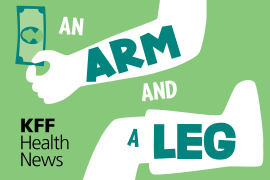Viewpoints: Mergers Causing Health Costs To Rise; Reauthorize CHIP; Obamacare’s Influence On Politics
The Wall Street Journal: Medical Mergers Are Driving Up Health Costs
Health care costs are going up, and there's a lot of debate about why. Is it the high cost of drugs or our aging population? Is it Americans' insistence on having the newest, most high-tech care? Each of these may contribute to rising costs. But a close look at the data reveals that one factor is increasing costs in recent years more than anything else: consolidation among hospitals and doctors (Suzanne F. Delbanco, 9/30).
Bloomberg: Patient Health Doesn't Explain Cost Differences
The report, by Louise Sheiner, a senior fellow at Brookings, has drawn lots of attention because it brings into question decades of research by the Dartmouth Atlas of Health Care. The Dartmouth team's core findings have been that substantial variation exists in how health care is practiced in the U.S., and that, on average, higher cost does not correlate with higher quality. Together, these suggest it should be possible to reduce health-care costs without harming people's medical outcomes. ... Enter Ms. Sheiner. She accepts that costs vary from state to state in the U.S., but finds "little support" for the notion that differences in medical practice are to blame. What does explain the variation, she claims, is the underlying health of patients: The states with higher costs simply have sicker people (Peter R. Orszag, 9/30).
Dallas Morning News: Congress Can Protect Texas Kids By Reauthorizing CHIP
What if there were a bipartisan health care plan that worked? What if it gave states lots of flexibility and represented a true private-public partnership? What if it delivered quality care for kids at a cost their parents can afford? And what if it were incredibly successful and overwhelmingly popular with voters? You’d think Congress would be rushing to protect it, wouldn’t you? Think again. The Children’s Health Insurance Program, or CHIP, was created by a Republican-controlled Congress and a Democratic president. Recent polling shows that CHIP continues to enjoy strong, bipartisan support. Why? Because CHIP works -- in Texas and nationwide (Bruce Lesley 9/30).
The Wall Street Journal: Why Public Interest Is Cooling In Obamacare As A Political Story
A hot debate continues about the ACA among partisans and experts, and health reform news will always resonate with the public because health is an issue that affects people personally. But unless there is a new development that garners media attention like the rollout did, the ACA story seems to be cooling as a front-page and political story, creating space for implementation to move forward less encumbered by constant controversy (Drew Altman, 9/30).
Los Angeles Times: Why So Many Voters Care So Little About The Midterm Elections
The looming midterm elections, which will decide whether the U.S. Senate is run by Democrats or Republicans, has been called "the Seinfeld election," because so much of the campaign seems to be about nothing. But that's not quite right. The problem is that the campaign has been about too many things. In Colorado, Senate candidates are bickering about birth control, abortion rights and whether "personhood" begins at birth. ... In Georgia, Senate candidates are in a "did so/did not" squabble over whether the Democratic candidate, in league with former President George H.W. Bush, sent money to terrorists. In Iowa, the divide between the parties has included castrating hogs and dealing with stray chickens, issues not covered in either party's official platform (Doyle McManus, 9/30).
The Washington Post: The Silly, Selective 'War On Women'
It has long been accepted by the conventionally wise that the Republican Party is waging a "war on women." Let's be clear. The war on women is based on just one thing -- abortion rights. While it is true that access to abortion has been restricted in several states owing to Republican efforts, it is not true that women as a whole care only or mostly about abortion (Kathleen Parker, 9/30).
USA Today: Anti-Abortionists Caught By 'Murder' Trap
Liberal Internet scribes opened fire over the weekend when National Review writer Kevin D. Williamson tweeted that women who get abortions should be executed by hanging. In one sense, the outrage made sense. Three out of 10 Americans will get an abortion by age 45. Hanging them would be a bloodbath unparalleled in U.S. history (Amanda Marcotte, 9/30).
Los Angeles Times: No On Proposition 45
Angered by rapidly rising premiums for automobile insurance, voters approved Proposition 103 in 1988 to give the state insurance commissioner the power to veto unreasonable rate hikes for auto policies. Now, after years of premium hikes in health insurance, voters have the chance to extend that authority to individual and small-group health policies. Proposition 45 would let the commissioner reject any change in premiums, deductibles or related factors found to be excessive, inadequate or "unfairly discriminatory." ... But now would be the wrong time to pass such a measure (9/30).
Politico: The Ebola Epidemic Is About to Get Worse. Much Worse.
The truth is that we are failing miserably at containing Ebola, despite daily pledges by governments and philanthropic organizations to provide more health care workers and additional financial and logistical support. It’s also despite the heroic work of a limited number of national and international volunteer health care workers and public health professionals who are risking their lives daily so that others may live and the epidemic can be stopped. ... In the end, the only guaranteed solution to ending this Ebola crisis is to develop, manufacture and deliver an effective Ebola vaccine .... This is Plan C, and it is still a long way off (Michael T. Osterholm, 9/30).
Bloomberg: Ebola Is Going Global. Or Not.
Public health authorities in industrialized nations have considerable expertise in preventing diseases from crossing international borders. The challenge is that someone infected with Ebola can carry the virus for as long as three weeks without showing any symptoms. It thus won't be surprising if cases start showing up elsewhere around the world. The most important time for response is now, before the resources required to contain the disease become many times greater. Effective response to an epidemic is as much about information as it is about medicine (Mark Buchanan, 9/28).
Vox: Don't Panic Over Ebola In America
The first thing to do is to calm down. Ebola is terrifying. But it's not likely to kill you, or to spread widely in the United States. What's scary -- and hyped -- about Ebola isn't what makes it dangerous. Ebola is a hemorrhagic fever. It kills about half of those who contract it. It sometimes, though not always, leads to uncontrollable bleeding. But it's difficult to contract. The only way to catch Ebola is to have direct contact with the bodily fluids -- vomit, sweat, blood, feces, urine or saliva -- of someone who has Ebola and has begun showing symptoms (Ezra Klein, 9/30).
Philadelphia Inquirer: Proceed With Caution: Corbett's Medicaid Plan Risks Severe Side Effects
The Corbett Administration continues to paint a rosy picture of its alternative Medicaid expansion plan, Healthy PA, and of what it will mean for those it will cover. The administration promises that the plan -- which will radically reduce the benefits of 1.2 million adult enrollees -- will "support independence" and "increase health care choices" for low-income Pennsylvanians. Patients, advocates and providers are right to oppose the plan’s many harmful elements, and it is important that the public understand what the proposal will do to our friends, our families, and countless patients in Pennsylvania (Antoinette Kraus, 10/1).
Journal of the American Medical Association: Evidence-Based Practice Is Not Synonymous With Delivery Of Uniform Health Care
[C]linical variation is considered one of the major drivers of ever-increasing health care costs contributing to the estimated 30 percent of inappropriate or wasteful health care. Perhaps as a natural response to this unsatisfactory situation, a widespread and influential school of thought has emerged contending that greater uniformity of clinical practice is desirable. ... The suggested mechanism to achieve uniformity in part involves clinician adherence to practice guidelines, which is seen as synonymous with evidence-based practice. In this Viewpoint, we explain that this position is based on a misunderstanding of trustworthy guidelines and that striving for uniformity of practice as an end is misguided (Drs. Benjamin Djulbegovic and Gordon H. Guyatt, 9/30).
Journal of the American Medical Association: The Connection Between Evidence-Based Medicine And Shared Decision Making
Links between evidence-based medicine [EBM] and shared decision making [SDM] have until recently been largely absent or at best implied. However, encouraging signs of interaction are emerging. For example, there has been some integration of the teaching of both, exploration about how guidelines can be adapted
to facilitate SDM, and research and resource tools that recognize both approaches. ... Medicine cannot, and should not, be practiced without up-to-date evidence. Nor can medicine be practiced without knowing and respecting the informed preferences of patients. ... Evidence-based medicine needs SDM, and SDM needs EBM. Patients need both (Tammy C. Hoffman, Dr. Victor M. Montori and Dr. Chris Del Mar, 9/30).
Journal of the American Medical Association: Managing Posthospital Care Transitions For Older Adults
For a generation, health policy experts have recommended longitudinal management of patients with significant chronic illness in a coherent, community-centered delivery system. However, meaningful change in communities and delivery systems has been slow. Concurrently, there has been wide, rapid deployment of intensive, expensive interventions such as hospitalist care, prompt cardiac angioplasty with drug-eluting stents for acute coronary ischemia, and extensive use of statins, sometimes without compelling evidence of overall benefit in the older, frail population. This history suggests that dissemination of more intensive solutions for coordinated management of complex patients may be more a matter of aligned incentives and momentum than of feasibility (Dr. Peter A. Boling, 9/30).






